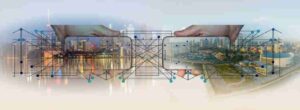As the pandemic is slowly coming to an end, we see how businesses are realising that they require to take a different approach to ensure Supply Chain Resilience. This new supply chain requirement has generated a supply chain skill uplift, as the “new” supply chain roles are looking to combine traditional supply chain experience with data analytics and digital enablement skills.

Over the years we have seen “supply chain” transitioning from solely dealing with two distinct functions, namely, materials management and physical distribution, towards a fully integrated end-to-end supply chain model that is able to track all activities from incoming materials to outgoing products. Additionally, supply chain has become a complex sequence of activities aiming to generate value to remain competitive in the global market.
More recently, the introduction of technology into the supply chain has required supply chain professionals have to be data and digitally literate, allowing the supply chains to be more resilient in meeting economic (e.g. trade tariffs), environmental (e.g. carbon reduction, waste management, water and energy efficiency), social (e.g. modern slavery and human trafficking) and governance challenges (e.g. bribery and corruptions, transparency, compliance).
Today’s supply chain professionals are tasked with building complementary supply chain solutions to unlock incremental capacity at low capital expenditure, enhance speed to market, and drive down fulfilment costs. The ability to design long-term strategies and capabilities to facilitate game-changing innovation, reduce capacity constraints across the core-network, unlock incremental financial supply chain profitability, and drive executive-level operational and supply chain initiatives, is a given to meet today’s and future operational and supply chain challenges.
However, to build a Supply Chain of the Future, we would recommend supply chain professionals (in your team) to adopt or enhance the following skills:
- Be familiar and understand Supply Chain Innovations that position the customer’s first,
- Be able to introduce simplicity, predictability, and economic efficiency to an organisation’s multifaceted supply chain that more than often spans the globe,
- Partner closely with other organisational functions to build out capabilities and operational models that support the organisation’s needs for cost-effective, scalable solutions including inventory/ storage/ warehousing, distribution, and customer fulfilment,
- Understand the importance of supply chain diversity through creating a supplier network that is local, regional, and global in nature, allowing continuous supply chain resilience,
- Introduce full supply chain transparency and visibility to further strengthen the end-to-end (financial) supply chain model,
- Able to assess and select a combination of best-of-breed technology solutions that add substantial value to the organisation’s operational and financial goals and targets.
And more recently, the importance of sustainable and ethical supply chain practices[1] have been a major supply chain requirement, ensuring that these practices can be monitored, assessed, and improved beyond an organisation’s own “walls”, and often down into the supply chain to “origin”.
Focus on effective development of your Supply Chain Team
To build your supply chain of the future requires you to develop the competencies of your supply chain team, such as digital and data literacy. Now there are multiple learning and development models, but we have seen how the 70:20:10 model[2] is seen as the most effective learning and development model to adopt the required skills
This model starts with the realisation of the (current and) future needs and motivations, and assumes that 70% comes from on-the-job experimental learning, working on tasks and problems that are often outside the supply chain professional’s comfort zone. 20% is obtained through development relationships, social learning, where the supply chain professional receives constructive feedback that guide his/ her supply chain role improvements. The final 10%, formal learning, is the traditional training and development initiatives through participation in courses and reading material.
Building the supply chain of the future starts with identifying what this looks likes, and subsequently developing your supply chain team. Only by effectively upskilling supply chain professionals, your business is able to effectively build your future supply chain…
[1] https://www.unique-excellence.com/esg-consulting
[2] https://en.wikipedia.org/wiki/70/20/10_Model_(Learning_and_Development)
Article by channel:
Everything you need to know about Digital Transformation
The best articles, news and events direct to your inbox
Read more articles tagged:






